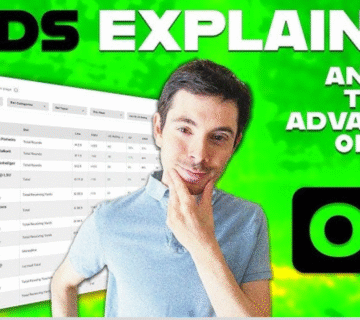If you have ever looked at the slabs and had the feeling that you have set a complicated math puzzle, you are not the only one. The possibility may seem intimidating with their fractures, decimal and more/min. But here’s the good news: understanding the game pistols is not as difficult as it seems. As soon as you break them down, you will see that they are less on missile Science Behind Betting Odds and more on mathematics and simple probability dressed in different sizes.
So we collect the jargon, simplify the figures and explain the Science Behind Betting Odds in normal English. Towards the end of this guide you feel safe enough to read opportunities as a professional – and perhaps also impress your friends.
What are the Science Behind Betting Odds anyway?
In essence, Groati are just a way to show two things:
The possibility that an event takes place (like a team that wins).
How much money you can win if your bet is correct.
Consider opportunities as the way to the bookmaker to say: “This is what is probable, and here is your potential payment when it happens”.
Why do bookmakers use opportunities? Bookmakers not only put opportunities for fun, but they do it for balance. The probability helps them:
Put bets on both sides of a competition or an event.
Make sure they make a profit, regardless of the result (thanks to something called “Vig” or margin).
In short, the possibility of predicting the results is not only, but also concern things.
The three most important types of opportunities
The possibility may seem different, depending on where you are playing. But don’t worry – they all mean the same thing, only written in different “languages”.
Break Opportunities (popular in Britain)
Example: 5/1 (“five to one”).
The first issue shows how much you win.
The second issue shows how much you need to bet.
A bet of £ 10 to 5/1 gives £ 50 (plus your original return £ 10). 2. Decimal opportunities (popular in Europe and online bets)
Example: 6.00
The number represents your total performance (distribution + profit).
A bet of $ 10 out of 6.00 rendered in total $ 60 ($ 50 win + $ 10 interests).
The simple multiplication is all you need here.
 Violations of the Silver Line (popular in the United States)
Violations of the Silver Line (popular in the United States)
Example: +200 or -150
A positive number (+200) tells you how many profit you will make with a bet of $ 100.
A negative number (-150) tells you how much you need to win $ 100.
+200 therefore means that the benefit of $ 100 wins the profit. -150 means that you have to bet 150 US dollars to earn US dollars.
How the probability of probability refers
Here, “science” comes into play. The chances are not accidental – they reflect the probabilities. Let it break it.
Break to probability: probability = denominator ÷ (denominator + meter).
Example: 5/1 winning opportunities → 1 ÷ (5 + 1) = 16.7% chance.
Probability department: probability = 1 ÷ decimal gain. Example: 6.00 → 1 ÷ 6.00 = 16.7% possibilities.
Money line in probability:
For positive opportunities: 100 ÷ (probability + 100).
For negative opportunities: opportunities ÷ (probability + 100).
This demonstrates the implicit probability: what the bookmaker thinks are opportunities.
The hidden margin: how bookmakers earn money
If you add the implicit opportunities of all possible results, you will notice something strange: they are more than 100%in total. That extra percentage is the margin of the bookmaker (also known as “Vig” or “Sap”).
Example: in a football match with two teams, implicit opportunities can rise to 104%. That 4% more is the profit margin of the bookmaker, integrated in opportunities.
Because the opportunities move over time
Have you ever noticed that the opportunities for a competition have changed? This happens because:
Flow of money: if too many people bet on the one hand, the bookmakers adapt the possibility of balanced the risk. New information: injuries, time or even insiders advice can influence the possibility.
Sentiment of the market: just like the prices of the shares, the possibility of where the crowd persists.
In short, the possibility of static is not static: they live and constantly respond to what is happening.
Gambling value: the intelligent way to read opportunities
Here is a secret: not all the opportunities are “right”. Sometimes bookmakers underestimate a team or player, which means that the possibility does not correspond to true probability. This is where the Science Behind Betting Odds comes into play. For example:
Bookmaker offenses involve 20% chance of winning.
His research suggests that the real chance is 30%.
It is an added value – you get a better chance that reality does not suggest it. The long -term weather conditions live for these possibilities.
Frequent misunderstandings on notes
Inform us some myths:
“Bigger chances of winning mean a better chance of winning.” Incorrect. Higher possibility means less possibilities, but a greater payment.
“Bookmakers know the future.” They don’t do it – they only balance the risk.
“The possibility of once set is set.” They always do on the basis of market activity.
The use of sad opportunities as a professional
If you have just started, here are the quick suggestions to make the Science Behind Betting Odds work:
The opportunity for probability is always upset: this gives you the real image.
Compare the opportunities between bookmakers – small correct differences. Look for bets on value, not just the favorite back.
Understand the risk than the reward: a higher payment often means a lower possibility.
Psychology behind opportunities
The possibility is not only the numbers: they influence behavior. Have you ever noticed how people like playing on long photos because the payment seems enormous? Bookmakers know it and often offer interesting opportunities on losers. This is part of mathematics, partly of psychology.
Read More: Betting on eSports: A Growing Trend in 2025
Conclusion
Science Behind Betting Odds conflicts may seem complicated at first, but they are just a mixture of mathematics and probability. Whether it is as ruptures, decimal or money lines, they answer the two simple questions: what is the height of the chances that this happens? And how much money can I earn if so?
Once you have understood science, the chances become less secret and rather a tool. Use them with wisdom and you will not only like to bet more: you may find opportunities that others are missing.



